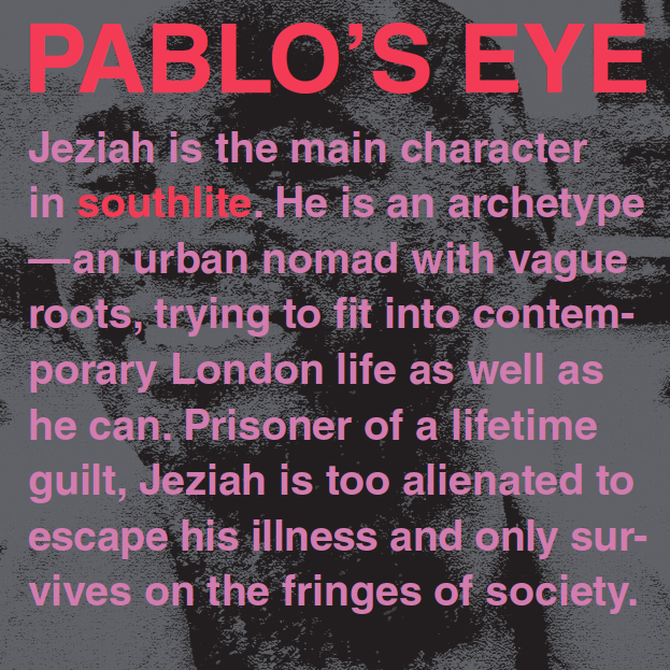The album opens gently, as series of modulations and drones gradually intercut with other, more discordant sounds. The slow, pulsing tracks are evocative of Loscil’s work, deep tunnels of expansive vibration and percussive texture suggesting a slow awakening, the self moving through phases of dream to consciousness, a sense confirmed by the narrator. “It was early morning…” she intones, “He began to make out sounds, as if someone were turning the volume up in his head,” the snippet a bridge to a heavier, more percussive sequence. Here, Pablo’s Eye blend reverb drenched tabla drums with other exoticised instrumentation, the earlier ambient meditation morphing into a series of intensifying drum and bass sequences. Throughout, the album counterpoints between these heavier parts and more introspective pieces that break down the pace and expand the mood. Despite this eclecticism, the album works beautifully as a coherent whole, the final track linking neatly with the opening. The production values have held up very well for an album that is almost twenty years old, or it might just be my own nostalgia for music from this period but there’s a pleasing warmth and organic wholeness to the sound, a hypnotic quality that conveys a true sense of being on a journey, a polyphony of overlapping sounds. This is music for psycho-geographers of both mind and place, a mood palette linking sonic locations with literal ones: an album to be listened to late at night or early in the morning, on the night bus home, watching the flicker of the passing city. Highly recommended.
|
“Southlite” is a lost nugget of late 90s dub electronica, a collaboration between the writer Richard Skinner and musical collective Pablo’s Eye originally planned as a soundtrack for a film that was never made. The forty-minute album is a shifting mosaic consisting of twenty tracks, a series of beguiling and eclectic excursions into ambient dub structured around short extracts from a previously unpublished novel by Richard Skinner. In the story, Jeziah, an urban nomad and apparent refugee arrives in the docks on a Dutch banana boat and struggles to find a place for himself in the city, his journey ending in Brixton police station, asking to be locked up. This narrative, deconstructed and re-contextualised by the music, drifts in and out of focus, words intoned by a hypnotic female voice, a strange journey through phases of alienation and rebirth. Around this, Pablo’s Eye weave a compelling tapestry of shifting sound and mood. Like the alienated narrator whose isolated journey through the fringes of London forms a loose narrative thread for the album, musically it inhabits a similarly liminal place, shifting in style, tempo and texture, a polymorphic symphony of dub-electronica. Pablo’s Eye describe themselves as “a temporary atmosphere, like a taste or a dream” whose music has the common goal of creating a feeling of travelling in time and space and this perfectly describes the effect of the album. Dub was forged in Jamaica by the ad hoc studio genius of producers like Lee Perry and King Tubby who pioneered methods of re-working rhythms for sound systems, breaking them down and expanding the levels, finding new moments of drama in the pace and drop, the sudden introduction and removal of percussion, their experiments pushed on for ever heavier and harder dubplates to satisfy the demands of the dancehall. These early ‘remixes’ reveal an almost infinite series of rhythmic and tonal variation within a song, allowing for continual reworkings and refreshments; in this sense every dub is also a collaboration, a musical palimpsest in which producer reworks producer reworks the musicians until traditional notions of authority and originality are completely effaced. As a result of this collaborative foundation, dub is a technique well evolved to translates the cosmopolitan vibration of multi-cultural London, a city where registers intersect and reconnect, styles can jump between cultures and hybridity is the norm, an approach clearly embraced by Pablo’s Eye.
The album opens gently, as series of modulations and drones gradually intercut with other, more discordant sounds. The slow, pulsing tracks are evocative of Loscil’s work, deep tunnels of expansive vibration and percussive texture suggesting a slow awakening, the self moving through phases of dream to consciousness, a sense confirmed by the narrator. “It was early morning…” she intones, “He began to make out sounds, as if someone were turning the volume up in his head,” the snippet a bridge to a heavier, more percussive sequence. Here, Pablo’s Eye blend reverb drenched tabla drums with other exoticised instrumentation, the earlier ambient meditation morphing into a series of intensifying drum and bass sequences. Throughout, the album counterpoints between these heavier parts and more introspective pieces that break down the pace and expand the mood. Despite this eclecticism, the album works beautifully as a coherent whole, the final track linking neatly with the opening. The production values have held up very well for an album that is almost twenty years old, or it might just be my own nostalgia for music from this period but there’s a pleasing warmth and organic wholeness to the sound, a hypnotic quality that conveys a true sense of being on a journey, a polyphony of overlapping sounds. This is music for psycho-geographers of both mind and place, a mood palette linking sonic locations with literal ones: an album to be listened to late at night or early in the morning, on the night bus home, watching the flicker of the passing city. Highly recommended. Comments are closed.
|
AuthorWriter working across fiction, life writing, essays, non-fiction & poetry. Categories
All
|

